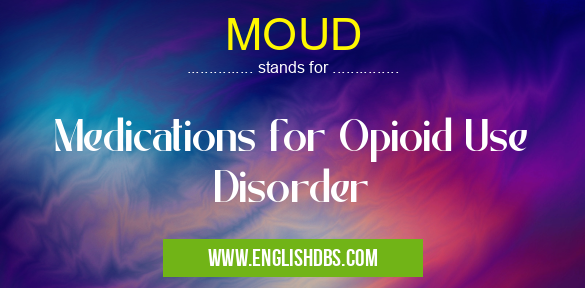What does MOUD mean in MEDICAL
MOUD is an abbreviation that stands for Medications for Opioid Use Disorder. These medications are used to treat people who are addicted to opioids, such as heroin or prescription painkillers. MOUD can help people to reduce their cravings for opioids, prevent relapse, and improve their overall health and well-being.

MOUD meaning in Medical in Medical
MOUD mostly used in an acronym Medical in Category Medical that means Medications for Opioid Use Disorder
Shorthand: MOUD,
Full Form: Medications for Opioid Use Disorder
For more information of "Medications for Opioid Use Disorder", see the section below.
Types of MOUD
There are three main types of MOUD:
- Methadone: Methadone is a long-acting opioid agonist that is taken orally. It works by binding to the same receptors in the brain as opioids, which reduces cravings and withdrawal symptoms.
- Buprenorphine: Buprenorphine is a partial opioid agonist that is taken sublingually (under the tongue). It binds to the same receptors as opioids, but it has a lower affinity for them than methadone. This means that it produces less euphoria and has a lower risk of overdose.
- Naltrexone: Naltrexone is an opioid antagonist that is taken orally or by injection. It blocks the effects of opioids, which can help to prevent relapse.
Benefits of MOUD
MOUD has been shown to be effective in treating opioid addiction. It can help people to:
- Reduce their cravings for opioids
- Prevent relapse
- Improve their overall health and well-being
- Reduce their risk of overdose
Essential Questions and Answers on Medications for Opioid Use Disorder in "MEDICAL»MEDICAL"
What are Medications for Opioid Use Disorder (MOUD)?
Medications for Opioid Use Disorder (MOUD) are FDA-approved medications used to treat opioid addiction. They work by reducing cravings and withdrawal symptoms, helping individuals maintain recovery and prevent relapse.
What types of MOUD are available?
The three main types of MOUD are methadone, buprenorphine, and naltrexone. Methadone and buprenorphine are opioids that reduce cravings and withdrawal symptoms. Naltrexone is an opioid antagonist that blocks the effects of opioids, reducing the risk of overdose.
How is MOUD administered?
Methadone is typically dispensed at specialized clinics and must be taken daily under observation. Buprenorphine can be prescribed and dispensed by healthcare providers who have received specific training in its use. Naltrexone can be administered as a daily pill or monthly injection.
What are the benefits of MOUD?
MOUD has been shown to improve treatment outcomes for opioid use disorder, including reducing cravings, withdrawal symptoms, and the risk of relapse. It can also help prevent overdose deaths, improve physical and mental health, and increase social functioning.
Are there any side effects of MOUD?
Yes, all medications have potential side effects. Common side effects of MOUD include constipation, nausea, and drowsiness. Serious side effects, such as respiratory depression, are rare but can occur. It is important to take MOUD as prescribed and follow the instructions of your healthcare provider.
How long should I take MOUD?
The duration of MOUD treatment varies depending on individual needs and circumstances. Some people may benefit from short-term treatment, while others may need long-term or indefinite treatment. Your healthcare provider will work with you to determine the best treatment plan for your situation.
Can I combine MOUD with other treatments?
Yes, MOUD can be combined with other treatments for opioid use disorder, such as behavioral therapy and support groups. This comprehensive approach can improve treatment outcomes and increase the likelihood of long-term recovery.
Final Words: MOUD is a safe and effective treatment for opioid addiction. It can help people to get their lives back on track and live healthy, productive lives.
